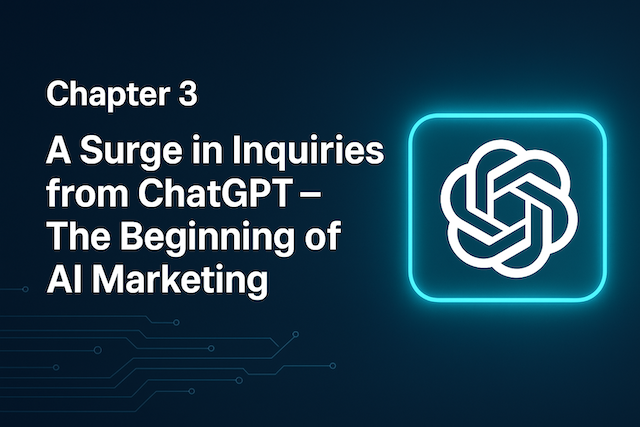Chapter 3: A Surge in Inquiries from ChatGPT — The Beginning of AI Marketing

Contents
Chapter 3: A Surge in Inquiries from ChatGPT — The Beginning of AI Marketing
(Written in November 2025)
In 2024, the number of Saudi Arabian students at 3D ACADEMY increased dramatically.
At first glance, our international marketing strategy seemed to be a great success.
However, beyond the Saudi market, we continued to struggle to achieve a real breakthrough with other nationalities.
Around this time, I began using ChatGPT more frequently—not only for research and writing but also to seek advice on business strategy and expansion.
What amazed me most was how easily ChatGPT could answer nearly every technical question I had about managing our website—whether it was WordPress, PHP, or general web operations.
From the end of 2024 through the first quarter of 2025, I found myself asking ChatGPT questions almost every day (of course, using the paid version).
In March 2025, I added a short survey to the inquiry form on our English website.
Alongside options such as Google and social media, I included a new checkbox for “ChatGPT.”
To my surprise, I soon noticed that a growing number of inquiries were coming through the “ChatGPT” channel.
This led me to realize that our English website could become a powerful tool to attract students of various nationalities—and so I began studying AI-driven marketing in earnest.
At the same time, my curiosity about AI itself grew stronger.
I enrolled in a G-Certification course through Aglot, aiming to deepen my understanding of AI, and even considered pursuing a master’s degree in the field.
Perhaps this was just my “study habit” kicking in again—but in the end, acquiring a solid foundation in AI proved to be extremely valuable.
3-1. Launching a New English Website (studyenglishdirect.com)
The first step of my AI marketing journey actually began with a failure.
Being someone who enjoys trying new things, I believed that by producing a large volume of English content through an AI + human hybrid approach, I could build a new kind of website capable of thriving in the age of AI.
In May 2025, right after completing the G-Certification exam, I spent just one to two weeks publishing over 200 articles.
However, the result was disastrous.
The main reason was domain age.
Google places strict limitations on new domains, and it is said that it can take six months to a year before a new site gains stable visibility in search results.
Without thinking too deeply about it, I launched the site on a brand-new domain—and as expected, after one or two weeks, the site had virtually zero traffic.
Even though I registered new pages daily through Google Console, there was almost no access coming from Google searches.
No matter how much high-quality content you create, it is meaningless if Google doesn’t recognize it.
Fortunately, I made a quick decision to cut my losses early and shift content production to the older domain of our English school website, which had over a decade of history.
That decision in late May turned out to be a major turning point.
3-2. Content Creation on the English School Website
Having managed an SEO company for many years, I already had a solid understanding of what constitutes high-quality content.
However, when it came to AI marketing, I began developing my strategies in consultation with ChatGPT.
Content generated solely by AI carries the risk of being flagged by Google as spam.
Therefore, I continued to study one key question:
“What kind of content will be recognized and even referenced by AI itself in the age of AI?”
In the end, what I was doing came down to the absolute fundamentals of SEO—executing the basics consistently and with discipline.
The most important factor is what kind of articles to write.
Writing about topics unrelated to the English school would never help improve the domain’s authority.
So I narrowed my focus to three key themes: Cebu, the Philippines, and English study, and kept experimenting within those boundaries.
Even so, the first month—June—brought almost no visible results.
Despite using a domain with over ten years of history, traffic barely increased.
To make matters worse, after Google’s Core Update on June 30, hundreds of articles failed to gain any ranking improvement.
It was a difficult month, but not giving up proved to be the key to success.
I simply kept believing in the process and continued creating high-quality content every single day through an AI + human editing approach.
3-3. Traffic Growth Begins in the Second Month
The results finally started to appear in July.
Following ChatGPT’s advice, I decided to fully commit to one of the most fundamental SEO principles: the pillar page strategy.
The pillar page strategy involves creating multiple articles around the same topic and organizing them under a single, comprehensive “pillar page” that serves as the central hub.
In my case, I began by building the pillar pages first, then linked each related post back to them.
This structural, internally linked approach convinced me that it is one of the most effective SEO success factors in the modern era.
While external links tend to grow naturally over time, internal links must be deliberately designed.
And in today’s SEO environment, I believe that internal link structure has become even more important than external backlinks.
After about five to six months of steady effort,
our English website—once attracting only 15 unique visitors per day—had grown to over 370 daily users.
Now, as I wait for Google’s next core update, I’m eager to see just how much further this growth can go.
The next part of this story will be written after the update.




